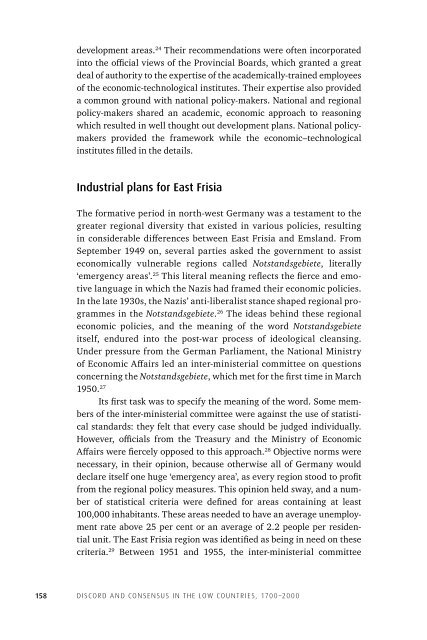Discord Consensus
7aze300jFJo
7aze300jFJo
Create successful ePaper yourself
Turn your PDF publications into a flip-book with our unique Google optimized e-Paper software.
development areas. 24 Their recommendations were often incorporated<br />
into the official views of the Provincial Boards, which granted a great<br />
deal of authority to the expertise of the academically-trained employees<br />
of the economic-technological institutes. Their expertise also provided<br />
a common ground with national policy-makers. National and regional<br />
policy-makers shared an academic, economic approach to reasoning<br />
which resulted in well thought out development plans. National policy-<br />
makers provided the framework while the economic–technological<br />
institutes filled in the details.<br />
Industrial plans for East Frisia<br />
The formative period in north-west Germany was a testament to the<br />
greater regional diversity that existed in various policies, resulting<br />
in considerable differences between East Frisia and Emsland. From<br />
September 1949 on, several parties asked the government to assist<br />
economically vulnerable regions called Notstandsgebiete, literally<br />
‘emergency areas’. 25 This literal meaning reflects the fierce and emotive<br />
language in which the Nazis had framed their economic policies.<br />
In the late 1930s, the Nazis’ anti-liberalist stance shaped regional programmes<br />
in the Notstandsgebiete. 26 The ideas behind these regional<br />
economic policies, and the meaning of the word Notstandsgebiete<br />
itself, endured into the post-war process of ideological cleansing.<br />
Under pressure from the German Parliament, the National Ministry<br />
of Economic Affairs led an inter-ministerial committee on questions<br />
concerning the Notstandsgebiete, which met for the first time in March<br />
1950. 27<br />
Its first task was to specify the meaning of the word. Some members<br />
of the inter-ministerial committee were against the use of statistical<br />
standards: they felt that every case should be judged individually.<br />
However, officials from the Treasury and the Ministry of Economic<br />
Affairs were fiercely opposed to this approach. 28 Objective norms were<br />
necessary, in their opinion, because otherwise all of Germany would<br />
declare itself one huge ‘emergency area’, as every region stood to profit<br />
from the regional policy measures. This opinion held sway, and a number<br />
of statistical criteria were defined for areas containing at least<br />
100,000 inhabitants. These areas needed to have an average unemployment<br />
rate above 25 per cent or an average of 2.2 people per residential<br />
unit. The East Frisia region was identified as being in need on these<br />
criteria. 29 Between 1951 and 1955, the inter-ministerial committee<br />
158<br />
DISCORD AND CONSENSUS IN THE LOW COUNTRIES, 1700–2000


